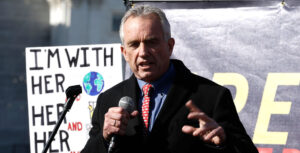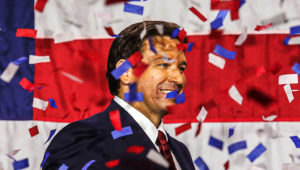An insurgent Democrat with a famous last name announces a primary challenge against his party’s sitting president. He infuriates the establishment, who accuse him of running a vanity campaign and helping the other side to win. Amid widespread dissatisfaction with the direction of the country, however, this candidate draws support from a broad range of Americans. The candidate’s initials are RFK.
The individual who comes to mind today might be Robert F. Kennedy Jr., currently running to unseat Joe Biden. But the description is of his father, Bobby Kennedy, who was assassinated 55 years ago this week. Today, he is remembered as an icon of liberal idealism who seemed, for a fleeting moment, to reconcile the racial tensions of that tumultuous time. In the 82 days of his campaign, there were glimmers of a new way of doing politics, one that stood in opposition to the excesses of both Sixties radicalism on the Left and the reactionary impulses on the Right. These are the same fault lines that score American society today; it is here, as the Democrats attempt to sail gingerly between the extremes of wokism and Trumpism, that RFK Sr.’s campaign is instructive.
His quest for the White House took place at the end of what we now see as the New Deal era. The enactment of Civil Rights in 1964, followed by deep divisions over Vietnam and the ascendancy of the counterculture, carved fatal cleavages within the Democratic coalition. By 1968, the beleaguered president, Lyndon B. Johnson, seemed to personify the exhaustion of American liberalism, as he struggled to maintain support in the face of a failing war overseas and the dramatic splintering of his party between its working-class and liberal activist wings. The white-working class vote in the Northern cities, which formed a core part of the Democratic base, joined the Solid South in drifting toward Richard Nixon’s Republican Party. And that exodus reduced the Democrats to an uneven alliance of affluent liberals and working-class minorities. The GOP ended up with an analogous dynamic, with conservative “country club” business elites commanding the electoral support of downscale whites.
In subsequent decades, American politics would see Democratic and Republican elites converge on a post-New Deal programme of de-industrialisation and hyper-financialisaton that served to benefit themselves, while compensating their respective portions of the working-class electorate with gestures of rhetorical and symbolic affirmation (what Nancy Fraser has called “the politics of recognition”). And this realignment persists to this day. But the Kennedy campaign of 1968 rested on entirely different premises: that an alternative coalition could be forged from the support of working-class white and black voters alike. In part, this strategy was born of a genuine conviction that the races could be brought together on the basis of common material interest and patriotic sentiment — but it was also born of political expediency.
The constituency who could most readily be enlisted in a fight against LBJ — the largely white, and ultra-liberal college-educated youths who powered the anti-war movement — had already spoken for themselves. They had come out for Minnesota Senator Eugene McCarthy, who had beaten the indecisive Kennedy to the punch in announcing a primary challenge against Johnson in March 1968. Not only did Kennedy end up forfeiting the college crowd, his late entry had turned many of them against him: in their eyes, he was a power-hungry opportunist bent on stealing McCarthy’s thunder. In order to win, Kennedy would have to court a different set of voters, namely Americans on the lower end of the social-economic ladder from both races. The first test of Kennedy’s strategy would come in Indiana, where he was up against McCarthy and favourite son Governor Roger Brannigan, oldline Democrat and proxy for the party establishment.
In the flurry of speeches he gave to white and black voters in cities across the state, Kennedy would express liberal-sounding views on social justice, economic fairness, and ending the war, but combined them with conservative-sounding positions on patriotism and law and order, the last issue being particularly relevant in light of an epidemic of crime in American cities. As he saw it, rioting was never permissible no matter how morally compelling the underlying cause. This set Kennedy apart from McCarthy, who consistently avoided using the term “law and order”, which (then as now) was widely interpreted to carry racial connotations. Kennedy’s willingness to speak directly to the issue attested to the level of trust he placed in his audiences, refusing to change his message according to the perceived preferences of the crowd.
On 4 April, just as he was set to stump before a mostly black audience in Indianapolis, the news broke that Martin Luther King Jr. had been shot and killed in Memphis. Though his bodyguards advised the he cancel his appearance out of fears for his safety, Kennedy insisted on speaking. What followed was one of the most extraordinary and uplifting speeches in modern American rhetoric: Kennedy acknowledged the bottomless well of anger and resentment that many in his audience felt but nonetheless appealed to the message of peace and brotherhood that King embodied. Indianapolis was spared from the rioting that consumed other cities that night.
Kennedy then won Indiana handily, gaining 42% of the vote to Branigan’s 31% and McCarthy’s 27%, and proving his viability as a presidential contender. He won 86% of black voters but also secured an impressive share of white working-class support. As evidence assembled by RFK campaign chronicler Thurston Clarke and liberal writer Richard Kalhenberg has shown, he won two-to-one among white ethnic, Catholic, blue-collar workers, including in seven of the biggest Indiana counties that voted for the segregationist George Wallace in the previous primary election cycle in 1964. (Wallace was also running again in 1968 and would be competitive with Nixon for the backlash vote in the general election.) Kennedy’s weak spot among Indiana voters had — unsurprisingly — been among affluent white liberals.
The rest of his campaign would follow the same pattern. Kennedy delivered inspiring speeches that synthesised the best of liberal and conservative arguments on many issues, while avoiding extremes and invoking America’s better angels. On welfare, he empathically acknowledged the depth of poverty and despair in the nation but nonetheless recognised the primacy of a commitment to work and family as the foremost solutions to the problem. On Vietnam, he echoed the anti-war movement’s disgust, but did so without disrespecting the flag or the patriotic attachments of everyday Americans; he also opposed student draft deferments that spared the well-off from the burden of the war.
On economic policy, Kennedy was able to match his words of compassion for the dispossessed with an actual record of material improvement, exemplified by his intervention in the poor black New York neighbourhood of Bedford-Stuyvesant. His innovative approach of scouting for new sources of private capital and proactively channelling investment toward organic job creation and community building efforts offered a path that was distinct from both the top-down managerial liberalism of old, and the callous neoliberalism that came to prevail in the Seventies and Eighties.
One wonders what could have been had Kennedy lived to advance this unique blend of cultural and economic stances at the national level. Perhaps the transition away from the New Deal era wouldn’t have been so traumatic: America might have avoided both the ruthless economic displacement experienced by the working class under Reagan and Clinton, and the divisive culture war that turned these same Americans against each other. Instead, under an RFK presidency, a different method of politics, one that acknowledged and incorporated the concerns of ordinary citizens, may well have succeeded.
Of course, it was not to be. Kennedy went on to win lily-white Nebraska but lost Oregon — also at the hands of affluent suburban voters who went strongly for McCarthy. The California primary in June was set to be the campaign’s decisive contest. Here, Kennedy reinforced his multiracial coalition by linking arms with Mexican-American farmworkers, Chicanos in the barrios, Native Americans in reservations, and Asian-Americans in L.A. and San Francisco. On 5 June, he scored his biggest win yet and hoped to convince the party bosses to support him in time for the convention in Chicago. He was shot just after giving his victory speech, while greeting staff at the kitchen of the Ambassador Hotel. He died the next day in the hospital.
In recent years, too many liberals have come to believe that the best way to beat their conservative foes is by doubling down in defence of cultural progressivism on issues such as crime, immigration, and battles over identity. But this merely encourages and empowers the reactionary Right, further inflaming the vicious cycle of mutual hatred and derision that consumes so many Americans. (The Right, too, has no shortage of unpopular obsessions — such as banning abortion.) Instead, they ought, like RFK, to abandon radical activist positions and aim at diffusing culture war by appealing to values that command the respect of Americans of all races and cultural creeds. Rather than a heedless revolutionary attitude towards institutions, of the kind shared by woke and MAGA fanatics alike, they might consider adopting a more patient and thoughtful reformist disposition, as Kennedy did in his efforts to fight poverty.
Unfortunately, I do not see his namesake as being up to the task: while RFK Jr. has certainly captured some of the insurgent energy of his father’s campaign, his politics don’t appear to be anywhere near as grounded or level-headed. In any event, the original RFK’s example stands as a lesson and inspiration for all Democrats to emulate. “Tis not too late to seek a newer world,” as Bobby said, borrowing from Tennyson. The 2024 election provides the opportunity to break out of the trenches American politics has been trapped in since the Sixties — and re-embrace the brief, electric potential of Bobby Kennedy’s dream.
Disclaimer
Some of the posts we share are controversial and we do not necessarily agree with them in the whole extend. Sometimes we agree with the content or part of it but we do not agree with the narration or language. Nevertheless we find them somehow interesting, valuable and/or informative or we share them, because we strongly believe in freedom of speech, free press and journalism. We strongly encourage you to have a critical approach to all the content, do your own research and analysis to build your own opinion.
We would be glad to have your feedback.
Source: UnHerd Read the original article here: https://unherd.com/




